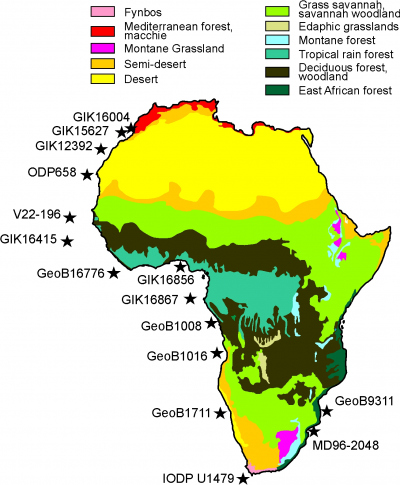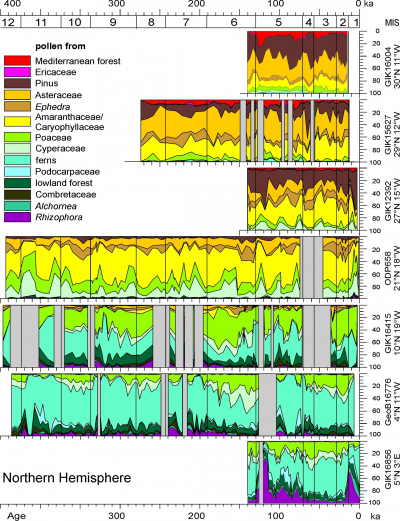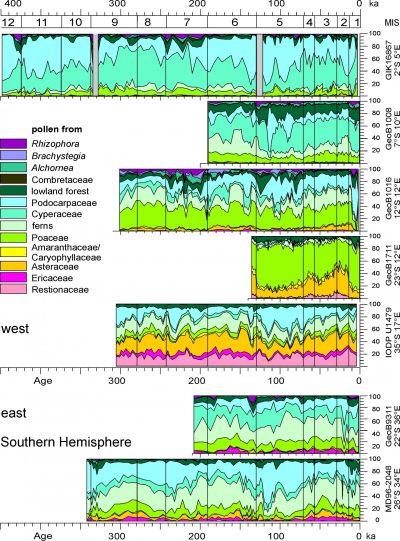- Home
- Reviews & summaries
Reviews & summaries
African vegetation change
Orbital change
Orbital scale vegetation change in Africa

Pollen and spores counted in marine sediments can be used as marker taxa for continental biomes. Alchornea for the rain forest, Combretaceae for woodland, Poaceae for the savannah, Asteraceae for the semi-desert, CCA (Caryophyllaceae, Amaranthaceae) for the Saharan desert, Podocarpaceae for the mountain forest, Ericaceae for mountainous scrubland, and Restionaceae for Fynbos. Rhizophora pollen in marine sediments mainly records rises in sea-level as the result of mangrove peat erosion. Pollen records covering several glacial interglacial cycles indicate the expansion and shrinking of Africa’s major biomes. The compilation of summary diagrams also indicates that despite strong fluctuations, the latitudinal arrangement of biomes has been conserved through the past three or four climate cycles. There is some tendency to increased forest vegetation during interglacials. However, the pacing of the fluctuations markedly differs between records.


Heinrich Stadials
Millennial-scale changes in vegetation records from tropical Africa and South America during the last glacial
Hessler I, Dupont L, Bonnefille R, Behling H, González C, Helmens KF, Hooghiemstra H, Lebamba J, Ledru MP, Lézine AM, Maley J, Marret F, Vincens A
Quaternary Science Reviews 29 (2010) 2882-2899
doi:10.1016/j.quascirev.2009.11.029
Other reviews
The Congo deep-sea fan as archive of Quaternary change in Africa and the eastern tropical South Atlantic (a review)
Lydie Dupont
In: Kneller B, Martinsen OJ, McCaffrey B (eds) External Controls on Deep-Water Depositional Systems.
Society for Sedimentary Geology, Special Publication 92 (2009) 79-87
Palaeoenvironmental changes in the arid and subarid belt (Sahara-Sahel-Arabian peninsula) from 150 Kyr to present
Hoelzmann P, Gasse F, Dupont LM, Salzmann U, Staubwasser M, Leuschner DC, Sirocko F
In: Batterbee RW, Gasse F, Stickley CE (eds) Past Climate Variability through Europe and Africa.
Springer (Dordrecht) (2004) 219-256
doi:10.1007/978-1-4020-2121-3_12
Older reviews
Vegetation change in equatorial West Africa: Time slices for the past 150 ka
Dupont LM, Jahns S, Marret F, Shi N
Palaeogeography, Palaeoclimatology, Palaeoecology 155 (2000) 95-122
doi.org/10.1016/S0031-0182(99)00095-4
Pollen and spores in marine sediments from the East Atlantic - a view from the ocean into the African continent
Lydie Dupont
In: Fischer G, Wefer G (eds) Use of Proxies in Paleoceanography.
Springer (Berlin) (1999) 523-546
Vegetation zones in NW Africa during the Brunhes Chron reconstructed from marine palynological data
Lydie Dupont
Quaternary Science Reviews 12 (1993) 189-202
doi.org/10.1016/0277-3791(93)90053-O


